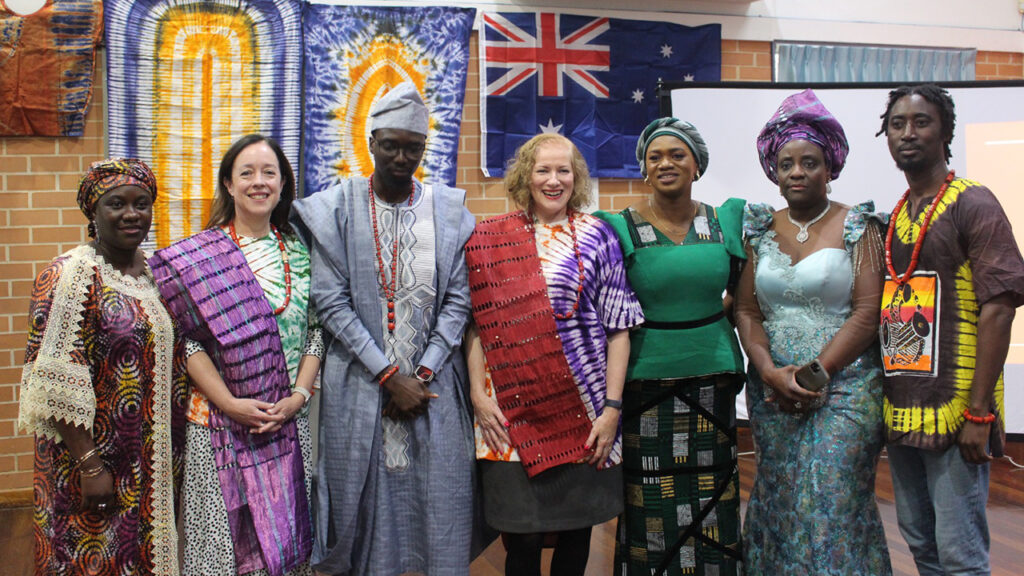
Influenced by the Brits, a painting by Olamide Ayomipo Adesola, also known as Ayo’lamide, is rooted in her migration journey from Nigeria to the United Kingdom and offers a rich tapestry of a theme that radiates her personal identity, colonialism and cultural adaptation. At first glance of the painting, the bold red background and the stylised portrayal of a young black woman evoke a sense of immediacy and visual impact. However, delving into Olamide’s artist statement reveals a multifaceted narrative that transcends mere aesthetic appeal.
The painting’s visual composition is striking, with a bold red background commanding immediate attention. This choice of color serves not only to evoke a sense of immediacy and vibrancy but also to symbolize the intensity of the emotions and experiences depicted within the painting. Against this backdrop stands a young black woman, whose gaze is direct and unwavering, capturing the viewer’s attention in a manner that invites contemplation.
The stylised portrayal of the central figure bears echoes of Paul Gauguin’s Tahitian paintings, infusing the artwork with a sense of exoticism and otherness. However, beneath this surface resemblance lies a deeper narrative, one that speaks to the artist’s personal journey and the broader themes of cultural adaptation and resilience.
Delving into Olamide’s artist statement provides valuable insights into the layers of meaning embedded within the painting. Central to the artwork is the portrayal of the migrant experience, with the young woman serving as a symbolic representation of the journey from familiarity to the unknown. Through her facial expression and body language, Olamide deftly conveys a range of emotions, from the apprehension and uncertainty of leaving behind the familiar to the hope and determination of forging a new path.
This painting is a rich comment about the continuing legacy of colonialism (neo-colonialism) and its adverse impact on cultural identity. Olamide’s choice of a young black woman as the central subject highlights the experiences of the black woman as a symbol of the struggles of the colonized peoples. The arrangement of the of traditional hair styling, which in itself brings to mind the ancient Nok culture, within the unfamiliar cultures encountered in the new environment, is testimony to the tension experienced in an attempt to maintain and preserve one’s heritage while undergoing the pressures associated with assimilation.
The presence of the Union Jack wrapped around the figure’s shoulder adds depth to the painting’s story. The flag represents how British colonialism has shaped the artist’s identity and heritage, thus, its presence highlights the challenges of adapting to new cultures while at the same time attempting to preserve ones, and the lasting effects of imperialism on migration experience.
The use of color palette and composition further enriches the artwork’s narrative, with vibrant hues and stylized elements adding depth and complexity to the visual storytelling. Each brushstroke becomes a testament to the artist’s own journey of self-discovery and adaptation, as well as a reflection of the broader human experience of migration and displacement.
In essence, Olamide’s ‘Influenced by the Brits’ transcends mere representation, inviting viewers to engage with its themes on a deeper level. It prompts reflection on the universal human quest for belonging and identity, while also shedding light on the specific challenges and triumphs faced by migrants, particularly those from marginalized communities.
Through her art, Olamide Ayomipo Adesola not only shares her personal narrative but also amplifies the voices of those whose stories are often overlooked or marginalized. In doing so, she contributes to a broader conversation about migration, cultural diversity, and the ongoing struggle for social justice and equality. Her painting becomes not just a work of art but a powerful testament to the resilience and spirit of those who dare to forge new paths in search of a better future.
• Ashiyanbi, Research Fellow II, Institute of African Studies, Cornelius Adepegba Museum of African Art, University of Ibadan.











